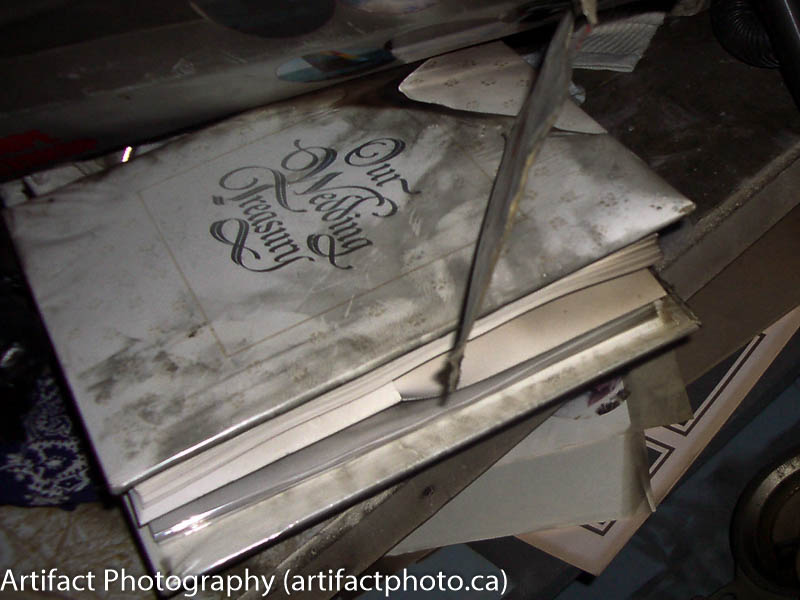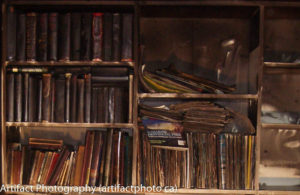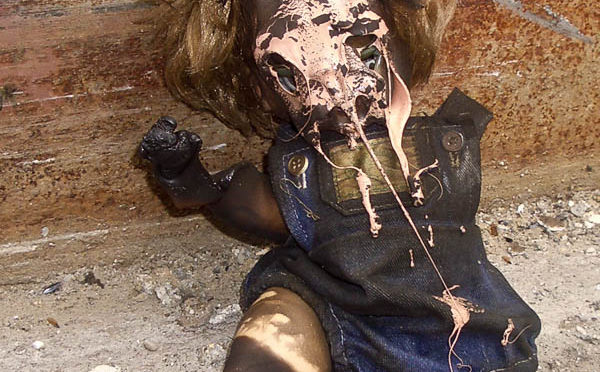Everything’s going along fine, and then, whoosh!! A fire happens. This is why I got into artifact photography in the first place.
It wasn’t my house. I was close to the owners. Thankfully nobody got killed or even badly hurt. But they lost everything. It was a three story house, and the fire started on the second floor in a bedroom. The bed burned through the floor to the dining room below, but overall, surprisingly little of the house caught fire. Most of the damage was from high heat and dense smoke. Everything in the house was covered in soot.

The computer on the second floor melted. Books on the third floor were intact but unclean-able. Keepsakes throughout the house were soot covered, melted, or vaporized. The oval of soot in the photograph is all that remained of the only portrait of the owner’s great grandmother.
Most of the intense heat stayed within the upper six feet of the second floor. You can see the scorch line in the photograph. The third floor just got smoke damage. The first floor got the bedroom in the dining room, and a lot of smoke damage.

The wedding album could have been cleaned, but insurance didn’t cover it.

I pulled the hard drive out of the computer, bought a USB adapter for it and managed to retrieve all of the data and photographs off of it. But how many people actually download all of the photographs on their phones and cameras regularly? She didn’t. She lost a bunch.
We were close, so I happened to have photographs of many of the events she needed photographs of, so I created a new album for her. Tears flowed.
Being a disaster recovery specialist, it occurred to me that much of the loss could have been avoided by having backup copies of all important photographs and artifacts stored off-site. Like the photo album I was able to recreate for her.
So:
Things to photograph:
- anything there is only one of (heirlooms, keepsakes, the marks you put on the door frame showing your child’s heights)
- anything that is difficult to replace (wedding albums, vacation albums)
- anything of high value you need the insurance company to take note of (model, make, serial number, condition of machines, furniture, goods)
Things to transfer to other media:
- personal video
- old home movies
- slides
- personal audio recordings
Where to put it:
- Assemble all of the images and recordings onto a DVD or series of DVDs or Blu-Rays, or if necessary, a portable hard drive.
- Copy the DVDs or hard drives onto similar media, and keep two copies at home (DVDs can be kept in the bottom of a chest freezer – its the last thing to burn in a house fire). Keep at least one copy off-site (at work, or give it to a relative or friend to keep for you).
- You may consider putting a copy in “the cloud”, but ensure you keep copies you control on media you own.
- Every year, assess the likelihood that your media will no longer be accessible. Technology changes. We used to have CD and floppy disk drives on every computer. Now we don’t. USB may not be with us much longer. If you think it’s going away, transfer the contents to another media (3 copies – 2 at home, 1 away).
- Every three years, transfer the DVD contents to new DVDs or whatever technology is current. Recordable DVDs don’t last forever. There are, however, new archival DVDs and Blu-Ray disks that are guaranteed to last 50 years at a slightly higher price point. I haven’t tried them yet, but I intend to soon: Panasonic Archival Blu-Ray
The point is, once you create a backup, you should periodically go back to it and see if it still works, or is still relevant. Before you change technologies, make sure the old media has been changed to whatever you are heading for.

And keep a copy on paper, since paper is known to last for centuries and still be readable. Books even survive fires. They stink, and may need to be cleaned, but they survive.
I always say, “Plan for the worst, and you will usually be pleasantly surprised.”
This blog is published every Monday at 9:00 am, Eastern Standard Time. If you have comments, questions, or can think of a better approach, feel free to leave a comment. I’ll try to get back to you with a pithy answer.
Feel free to explore the rest of the Artifact Photography (a division of 1350286 Ontario Inc.) website at www.artifactphoto.ca
